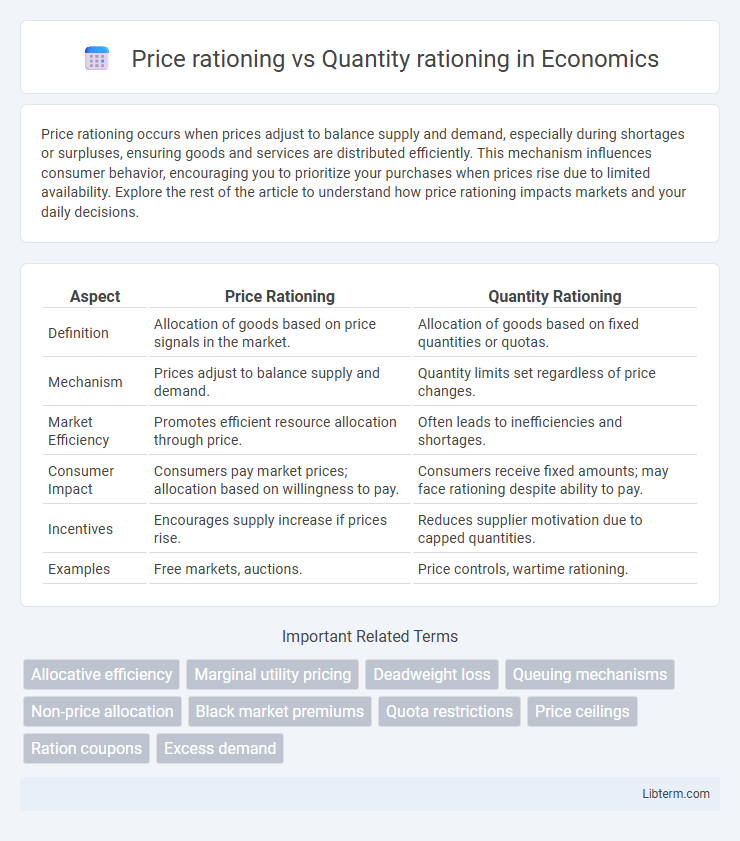Price rationing occurs when prices adjust to balance supply and demand, especially during shortages or surpluses, ensuring goods and services are distributed efficiently. This mechanism influences consumer behavior, encouraging you to prioritize your purchases when prices rise due to limited availability. Explore the rest of the article to understand how price rationing impacts markets and your daily decisions.
Table of Comparison
| Aspect | Price Rationing | Quantity Rationing |
|---|---|---|
| Definition | Allocation of goods based on price signals in the market. | Allocation of goods based on fixed quantities or quotas. |
| Mechanism | Prices adjust to balance supply and demand. | Quantity limits set regardless of price changes. |
| Market Efficiency | Promotes efficient resource allocation through price. | Often leads to inefficiencies and shortages. |
| Consumer Impact | Consumers pay market prices; allocation based on willingness to pay. | Consumers receive fixed amounts; may face rationing despite ability to pay. |
| Incentives | Encourages supply increase if prices rise. | Reduces supplier motivation due to capped quantities. |
| Examples | Free markets, auctions. | Price controls, wartime rationing. |
Introduction to Rationing: Definition and Importance
Rationing allocates scarce resources by controlling access when demand exceeds supply. Price rationing uses price adjustments to balance demand and supply, encouraging consumers to self-regulate based on willingness to pay. Quantity rationing limits the amount available per consumer, often implemented through quotas or ration cards, ensuring equitable distribution during shortages.
Understanding Price Rationing: Basics and Mechanisms
Price rationing determines the allocation of scarce goods through price adjustments, where higher prices reduce demand and balance supply. This mechanism relies on market signals to efficiently distribute resources by encouraging consumers to pay a premium or reduce consumption when goods are limited. Understanding price rationing involves analyzing how price elasticity and consumer willingness to pay drive equilibrium in supply-constrained markets.
Quantity Rationing Explained: Concepts and Applications
Quantity rationing refers to the controlled distribution of limited goods by restricting the amount each consumer can purchase, rather than adjusting the price to balance supply and demand. This method is commonly applied during shortages, such as fuel crises or housing allocation, where governments or organizations impose fixed quotas to ensure equitable access. Unlike price rationing, which uses price signals to regulate consumption, quantity rationing emphasizes fairness and social stability by limiting the quantity available per individual.
Key Differences Between Price and Quantity Rationing
Price rationing allocates goods based on consumers' willingness and ability to pay, using price as the primary mechanism to balance supply and demand. Quantity rationing restricts the amount each consumer can purchase, regardless of price, often leading to shortages or black markets. Key differences include price rationing's efficiency in clearing markets and signaling scarcity, whereas quantity rationing may cause inefficiencies and reduced incentives for producers.
Economic Theories Supporting Each Rationing Method
Price rationing aligns with neoclassical economic theory emphasizing market equilibrium where prices adjust to balance supply and demand, efficiently allocating scarce resources through price signals. Quantity rationing is supported by Keynesian economics and institutional theories, which argue that non-price controls, such as quotas or ration cards, are necessary to manage allocation during market failures or external shocks. These contrasting methods reflect differing assumptions about market conditions and the role of government intervention in resource distribution.
Real-World Examples: Price vs Quantity Rationing
Price rationing occurs when prices adjust based on supply and demand, such as surge pricing in ride-sharing platforms like Uber, where prices rise during high demand to allocate limited drivers efficiently. Quantity rationing is evident in government-imposed limits, such as gasoline rationing during the 1970s oil crisis, where consumers were restricted to fixed fuel quantities despite willingness to pay higher prices. Real-world applications show that price rationing offers flexibility and market efficiency, while quantity rationing enforces strict consumption limits often in response to shortages or regulatory policies.
Efficiency and Equity Implications of Rationing Systems
Price rationing allocates goods based on consumers' willingness and ability to pay, promoting efficiency by directing resources to those valuing them most, but often exacerbates equity concerns by disadvantaging low-income individuals. Quantity rationing limits the amount of goods distributed, aiming for fairness through equal access, yet can lead to inefficiencies such as shortages, black markets, and misallocation of resources. Balancing efficiency and equity in rationing systems requires careful consideration of the trade-offs between market-driven allocations and regulated distribution mechanisms.
Advantages and Disadvantages of Price Rationing
Price rationing efficiently allocates goods by adjusting prices to balance supply and demand, preventing shortages and encouraging producers to increase output. It provides clear signals to consumers and suppliers, promoting resource allocation based on willingness to pay, but can lead to inequality as higher prices may exclude low-income buyers. Disadvantages include potential inflationary effects and reduced access to essential goods for vulnerable populations.
Pros and Cons of Quantity Rationing
Quantity rationing ensures fair distribution of scarce goods by limiting the amount each consumer can purchase, preventing stockpiling and promoting equity. However, it can lead to inefficiencies like black markets and reduced incentives for producers to increase supply. This method may also fail to reflect true demand, causing shortages or surpluses due to fixed quantity limits.
Policy Considerations and Choosing the Right Rationing Method
Price rationing allocates resources through price adjustments, allowing supply and demand to reach equilibrium, which is efficient but may disadvantage low-income groups. Quantity rationing involves fixed limits or quotas, ensuring equitable access but risking shortages and black markets, requiring careful regulatory oversight. Policymakers must balance economic efficiency with fairness, selecting rationing methods based on market conditions, administrative feasibility, and social equity goals.
Price rationing Infographic

 libterm.com
libterm.com